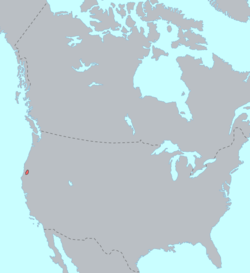
Summary
The Karuk Tribe is a federally recognized Indian tribe of Karuk people.[2] They are an indigenous people of California, located in the northwestern corner of the state, in Humboldt and Siskiyou counties. The Karuk Tribe is one of the largest Indian tribes in California.[1]
 Tribal Flag | |
 Karuk language distribution | |
| Total population | |
|---|---|
| 4,800 enrolled members[1] | |
| Regions with significant populations | |
| Languages | |
| English, Karuk | |
| Religion | |
| traditional tribal religion, Christianity | |
| Related ethnic groups | |
| other Karuk people |
As a government organization, the Karuk Tribe of California has demonstrated its ability to administer a multitude of social, cultural and economic programs effectively, earning the status of a "Self-Governance Tribe." The Tribal government currently employs more than 100 people in administrative, child welfare, community/economic development, education, elders, energy assistance, health, housing, human services and natural resources programs. In little more than a decade the Karuk Tribe has developed housing divisions, health clinics and Head Start programs in Orleans, Happy Camp and Yreka, its three major population centers. Through the tribally-chartered Karuk Community Development Corporation, the Karuk Tribe also has administered salmon fisheries enhancement projects, acquired and expanded a retail business, planned a small manufacturing plant, assisted a number of local people in starting small business enterprises and staffs Workforce Development personnel at Community Computer Centers in Orleans, Happy Camp and Yreka.
Land edit
The Karuk do not have a legally designated reservation but do have a number of small tracts held in trust by the federal government as well as tracts owned by the tribe in fee-simple status. These small non-contiguous parcels of land are primarily located along the Klamath River in western Siskiyou County and northeastern Humboldt County in California. The total land area of these parcels is 2.908 square kilometres (1.123 sq mi; 719 acres). A resident population of 333 persons was reported in the 2000 census. There are also a number of tracts located within the city of Yreka.
Government edit
The Karuk are headquartered in Happy Camp, California, governed by a nine-member council. As of 2016, it comprises:[3]
- Chairman: Russell "Buster" Attebery
- Vice-chairman: Robert Super
- Secretary/Treasurer: Michael Thom
- Member-at-large: Renee Stauffer
- Member-at-large: Arch Super
- Member-at-large: Sonny Davis
- Member-at-large: Wilverna Reece
- Member-at-large: Alvis Johnson
- Member-at-large: Kristen King
Language edit
The Karuk people speak the Karuk language, a Shastan language belonging to the Hokan language family.[4] The tribe has an active language revitalization program.[5][6] With fewer than twelve active full-time speakers alive as of 2015, Karuk (also known as Karok, Quoratem, Charoc, and Quoratean) is considered to be a severely endangered language according to the Endangered Languages Project.[7][8] Field recordings, primary texts, lexical resources, language descriptions, and other resources about the language have been archived by the University of California, Berkeley California Language Archive.[9]
The ISO 639-3 symbol for the Karuk language is kyh.[9]
Business edit
The tribe operates the Rain Rock Casino in Yreka, California.[10]
The People's Center in Happy Camp is the tribe's museum and cultural center. The 5,000-foot building has a changing gallery, museum store, classroom, library, office for the language program, and archives and collections storage.[11]
A tribally owned Internet service provider, Áan Chúuphan ("talking line"), installed fiber optic cable to provide Internet and cell service in the tribal center of Orleans. As of 2018, satellite internet access remains the only option for many residents.[12]
Notes edit
- ^ a b "Karuk Indians." SDSU: California Indians and Their Reservations. 30 July 2013.
- ^ Pritzker 428
- ^ "Karuk Tribal Council". Karuk Tribe. Retrieved 26 June 2016.
- ^ "Karuk."[usurped] Four Directions Institute. Retrieved 30 July 2013.
- ^ "Language Keepers: On the Fight to Save the Karuk Language". Emergence Magazine. 21 September 2020. Retrieved 5 January 2022.
- ^ Rogers, Chris; Palossari, Naomi; Campbell, Lyle (2010). "United States of America". In Christopher Moseley (ed.). Atlas of the World's Languages in Danger (3rd ed.). UNESCO. pp. 108–112. ISBN 9789231040962. Retrieved 5 January 2022.
- ^ "Karuk [aka Karok, Karuk, Quoratem]". ELP: Endangered Languages Project. Retrieved 5 January 2022.
- ^ Golla, Victor; Goddard, Ives; Campbell, Lyle; Mithun, Marianne; Mixco, Mauricio (2007). "North America". In Chris Moseley and Ron Asher (ed.). Atlas of the World's Languages (2nd ed.). Routledge. pp. 7–41. ISBN 9781315829845.
- ^ a b "OLAC resources in and about the Karok language". Retrieved 5 January 2022.
- ^ "Karuk Casino Yreka." 500 Nations. Retrieved 30 July 2013.
- ^ "Welcome to the People's Center." Archived 8 July 2013 at the Wayback MachineKaruk Tribe. Retrieved 30 July 2013.
- ^ Rogers, Kaleigh (16 April 2018). "What It's Like to Live in America Without Broadband Internet". Motherboard. Retrieved 18 April 2018.
References edit
- Pritzker, Barry M. A Native American Encyclopedia: History, Culture, and Peoples. Oxford: Oxford University Press, 2000. ISBN 978-0-19-513877-1
External links edit
- Karuk Tribe, official website
- Traditional Karuk Ceremonial Activity on the Klamath River, USDA Forest Service


